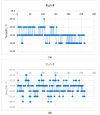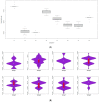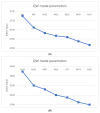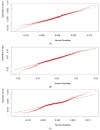Testing Thermostatic Bath End-Scale Stability for Calibration Performance with a Multiple-Sensor Ensemble Using ARIMA, Temporal Stochastics and a Quantum Walker Algorithm
- PMID: 36850864
- PMCID: PMC9963105
- DOI: 10.3390/s23042267
Testing Thermostatic Bath End-Scale Stability for Calibration Performance with a Multiple-Sensor Ensemble Using ARIMA, Temporal Stochastics and a Quantum Walker Algorithm
Abstract
Thermostatic bath calibration performance is usually checked for uniformity and stability to serve a wide range of industrial applications. Particularly challenging is the assessment at the limiting specification ends where the sensor system may be less effective in achieving consistency. An ensemble of eight sensors is used to test temperature measurement stability at various topological locations in a thermostatic bath (antifreeze) fluid at -20 °C. Eight streaks of temperature data were collected, and the resulting time-series were processed for normality, stationarity, and independence and identical distribution by employing regular statistical inference methods. Moreover, they were evaluated for autoregressive patterns and other underlying trends using classical Auto-Regressive Integrated Moving Average (ARIMA) modeling. In contrast, a continuous-time quantum walker algorithm was implemented, using an available R-package, in order to test the behavior of the fitted coefficients on the probabilistic node transitions of the temperature time series dataset. Tracking the network sequence for persistence and hierarchical mode strength was the objective. The quantum walker approach favoring a network probabilistic framework was posited as a faster way to arrive at simultaneous instability quantifications for all the examined time-series. The quantum walker algorithm may furnish expedient modal information in comparison to the classical ARIMA modeling and in conjunction with several popular stochastic analyzers of time-series stationarity, normality, and data sequence independence of temperature end-of-scale calibration datasets, which are investigated for temporal consistency.
Keywords: ARIMA; normality; quantum walker; sensor ensemble; stability; stationarity; temperature calibration; thermostatic bath; uniformity.
Conflict of interest statement
The author declares no conflict of interest.
Figures























Similar articles
-
Leukapheresis for autologous stem cell transplantation: Comparative study of two different thawing methods WSCFD(®) Stem Cell Fast Thawer KW versus 37 °C thermostatic bath.Transfus Apher Sci. 2015 Dec;53(3):342-7. doi: 10.1016/j.transci.2015.07.001. Epub 2015 Jul 14. Transfus Apher Sci. 2015. PMID: 26208787
-
[Comparison of predictive effect between the single auto regressive integrated moving average (ARIMA) model and the ARIMA-generalized regression neural network (GRNN) combination model on the incidence of scarlet fever].Zhonghua Liu Xing Bing Xue Za Zhi. 2009 Sep;30(9):964-8. Zhonghua Liu Xing Bing Xue Za Zhi. 2009. PMID: 20193238 Chinese.
-
Application of seasonal auto-regressive integrated moving average model in forecasting the incidence of hand-foot-mouth disease in Wuhan, China.J Huazhong Univ Sci Technolog Med Sci. 2017 Dec;37(6):842-848. doi: 10.1007/s11596-017-1815-8. Epub 2017 Dec 21. J Huazhong Univ Sci Technolog Med Sci. 2017. PMID: 29270741
-
Time series prediction of under-five mortality rates for Nigeria: comparative analysis of artificial neural networks, Holt-Winters exponential smoothing and autoregressive integrated moving average models.BMC Med Res Methodol. 2020 Dec 3;20(1):292. doi: 10.1186/s12874-020-01159-9. BMC Med Res Methodol. 2020. PMID: 33267817 Free PMC article.
-
Calibration and performance assessment of a temperature sensor prototype using a 1-point calibration procedure.Rev Sci Instrum. 2012 Nov;83(11):114907. doi: 10.1063/1.4767244. Rev Sci Instrum. 2012. PMID: 23206089
References
-
- Beier G., Niehoff S., Xue B. More Sustainability in Industry through Industrial Internet of Things? Appl. Sci. 2018;8:219. doi: 10.3390/app8020219. - DOI
-
- Salam A. Internet of Things for Sustainable Community Development. Springer Nature; Cham, Switzerland: 2020.
-
- United Nations . Transforming Our World: The 2030 Agenda for Sustainable Development. Department of Economic and Social Affairs, United Nations; New York, NY, USA: 2015. [(accessed on 14 September 2022)]. Available online: https://sdgs.un.org/2030agenda.
-
- Kumar S., Tiwari P., Zymbler M. Internet of Things is a revolutionary approach for future technology enhancement: A review. J. Big Data. 2019;6:111. doi: 10.1186/s40537-019-0268-2. - DOI
-
- Oke A.E., Arowoiya V.A. Evaluation of internet of things (IoT) application areas for sustainable construction. Smart Sustain. Built Environ. 2021;10:387–402. doi: 10.1108/SASBE-11-2020-0167. - DOI
LinkOut - more resources
Full Text Sources

